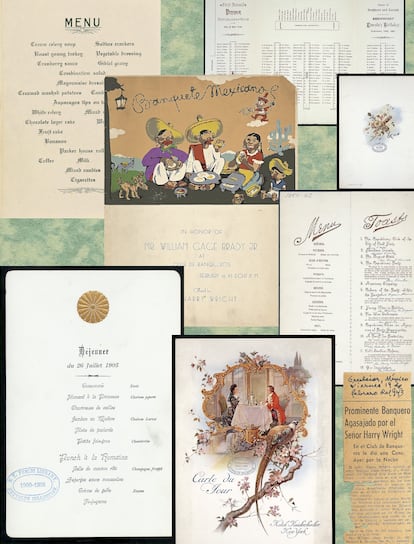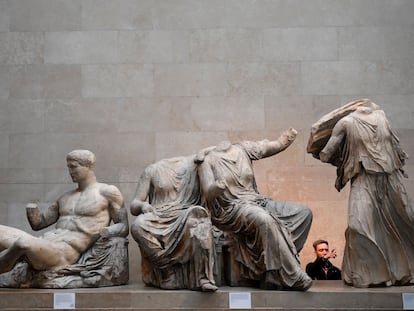New York Public Library houses a captivating and undiscovered archive of over 45,000 food menus
Explore a culinary treasure trove of oysters, fondue, terrapin à la Baltimore and much more

Hidden within the New York Public Library’s main branch on 42nd Street and Fifth Avenue, the rare book section awaits on the third floor’s north wing. It’s a captivating realm of old desks, exquisite showcases and lofty ceilings. Tucked away in the archives is a collection of 45,000 food menus awaiting the curious. With more staff members than readers, this treasure trove remains largely undiscovered.
It all began with collector Frank E. Buttolph. In 1899, he held onto his very first menu, and little did he know that it would be the catalyst for a remarkable collection of 25,000 menus dating from 1850 to 1924. These menus whisper tales of opulence, like the private dinner in 1890 held by Tsar Nicholas II at the Winter Palace in St. Petersburg, or the grand banquet hosted in 1905 by Emperor Mutsuhito in Tokyo. They reveal glimpses of luxury in menus from New York’s most exclusive hotels and even capture the essence of a Midwest Society of Physicians’ dinner.
“Miss Buttolph is preserving history for the year 2000,” exclaimed The New York Times in 1906. “Will our carnivorous natures then be transformed into a gentle, dairy diet? Will this generation be remembered as a symbol of brute force that destroys our virtues and paints us as a horrifyingly greedy race in the eyes of future generations?”
In 2011, the What’s on the Menu? project was launched to expand the collection, digitize it and conduct a data analysis. Scholars Katie Rawson and Trevor Muñoz led the initiative, which attracted a dedicated group of 10,000 volunteers who transcribed menu items from thousands of restaurants, resulting in the digitization of nearly 18,000 menus and 1.3 million dishes. Unfortunately, funding was discontinued in 2016, interrupting the project. Despite this setback, exploring this unfinished project’s website is still akin to falling down the rabbit hole into Alice in Wonderland.
The workers in the rare books section speak highly of the initiative, though they acknowledge that only two people have requested access to the material recently (one being the author of this article). They do not provide data online, but it’s evident that chefs can find an endless source of inspiration here. Dabiz Muñoz frequently travels the world to gather ideas for DiverXo, his restaurant in Madrid. Ferran Adrià's food laboratory at El Bulli (Roses, Spain) also gained fame as he relentlessly pursued the title of the world’s best restaurant. Culinary research also involves digging into historical archives. Muhannad Al Ateem, the chef at the Plaza Hotel in New York, says that during his first three months on the job, he spent significant time studying the hotel’s history and menus. The New York Public Library played a crucial role in this process. During preparations for the celebration of the Plaza’s 115th anniversary last year, they discovered the hotel’s opening day menu from October 1, 1907. This bilingual menu (English and French) included oysters priced at 60 cents, cheese fondue for 50 cents, and the most expensive dish — terrapin à la Baltimore — for $3.50 (equivalent to $112 today).
“I love looking for ingredients that have been used in the past and finding a way to keep those flavors alive today. I think about how to cook and present them in a way that preserves the experience that makes the Plaza so special,” says Al Ateem. “It’s all about trying to surprise people while making them feel like nothing has changed. Some customers even come in hoping to relive a dinner they had here 30 years ago.” For example, turtle meat can no longer be served and gluten intolerances and vegetarianism are more widespread. “We make sure that our menu doesn’t exclude you from the experience.” The diners have also changed. “Approximately 40% of the clientele is from the Middle East,” notes Al Ateem, a Jordanian. He sometimes replaces crème fraîche with labneh and has included hummus on the breakfast menu. Al Ateem also reintroduced a truffle scone from a 30-year-old menu, and has noted a shift in preferences from exotic international ingredients to local ones, especially after the pandemic supply crisis. “99% of the ingredients are from this region,” he says. “We used to import caviar from Iran and Russia, but now we make our own batches in collaboration with a U.S. company on the East Coast.”
It’s all about trying to surprise people while making them feel like nothing has changed. Some customers even come in hoping to relive a dinner they had here 30 years ago”Muhannad Al Ateem, chef at the Plaza Hotel in New York
The evolution of an industry and society as a whole is mirrored in the menu items, but also in their typography and illustrations. Professor Sheryl Kimes, who teaches a menu design course at Cornell University (New York), emphasizes the significance of research and data when crafting a successful restaurant menu. “That piece of paper or chalkboard at the entrance of a restaurant? It may seem simple, but for most restaurants, it’s the only way they have to convince people to step inside. And the restaurant industry is currently dealing with a lot of economic challenges,” she says. Kimes says naming a dish must be carefully considered. “These days, references to where things come from tend to hit the mark, like the classic example of Maine lobster. Emphasizing tradition also works well, like presenting a dish as Grandma’s recipe.” Indeed, this trend is not often seen in the archive’s older menus, which tend to describe dishes without embellishment. For instance, on June 13, 1951, the American House in Boston served boiled salmon in shrimp sauce, lamb ribs and pigeon stew, among other items. The menu prominently features the owner’s name (rather than the chef) and distinguishes between dishes for men and women. Older menus often feature an illustration of the restaurant building, which adds value for architecture enthusiasts. Notably, a veal head stew with Madeira sauce is the only geographical reference.
“It all depends on the culture and time period,” says Kimes. “For example, when it comes to the length of a menu, Western culture tends to value something concise. But in Asia, particularly in China, the longer the menu and the more images, the better. Photos are also pretty common in online menus where you don’t have a server to explain the dish.” As a marketing expert, she also analyzes menu trends. According to the 2023 report from the National Restaurant Association, consumers want a restaurant experience, and charcuterie boards and dishes with Sriracha sauce are in demand. Southeast Asian cuisine is the most popular, and sustainable food items are valued. Digging through the What’s on the Menu? archive, the most popular dishes in 1851 were apple pie, oranges, ham and roast beef. In the Roaring Twenties, it was shrimp cocktails and an assortment of desserts. In 1930, during the Great Depression, it was raw apples, Spanish melon (which appeared on several New York hotel menus), and vegetables with potatoes. In 1942, during World War II, the soup-of-the-day was a popular item, although the collection has few menus from that time. Moving on to the 1970s, you can find the menu that Air France offered on its Paris to New York flight — veal Marengo, Jura salad and an assortment of cheeses — putting current airplane food to shame.
And so, this dusty archive transforms into a treasure trove for gourmets, sociologists, historians, inflation analysts, marketing experts, illustrators and even marine biologists. It’s a tantalizing feast for both experts and curious souls alike, who eagerly await the day when funding becomes available to bring the What’s on the Menu? project to its delicious completion.
Sign up for our weekly newsletter to get more English-language news coverage from EL PAÍS USA Edition
Tu suscripción se está usando en otro dispositivo
¿Quieres añadir otro usuario a tu suscripción?
Si continúas leyendo en este dispositivo, no se podrá leer en el otro.
FlechaTu suscripción se está usando en otro dispositivo y solo puedes acceder a EL PAÍS desde un dispositivo a la vez.
Si quieres compartir tu cuenta, cambia tu suscripción a la modalidad Premium, así podrás añadir otro usuario. Cada uno accederá con su propia cuenta de email, lo que os permitirá personalizar vuestra experiencia en EL PAÍS.
¿Tienes una suscripción de empresa? Accede aquí para contratar más cuentas.
En el caso de no saber quién está usando tu cuenta, te recomendamos cambiar tu contraseña aquí.
Si decides continuar compartiendo tu cuenta, este mensaje se mostrará en tu dispositivo y en el de la otra persona que está usando tu cuenta de forma indefinida, afectando a tu experiencia de lectura. Puedes consultar aquí los términos y condiciones de la suscripción digital.
More information
Archived In
Últimas noticias
Welcome to the post-religion era: The idea of Christianity as the absolute truth has become obsolete
‘I thought you would like it’: The risky sexual practice popularized by TV shows and TikTok
The digitalization of tourism: ‘They promise experiences and gave us the worst possible one’
Mexican peso defies uncertainty with forecasts of a new period of stability in 2026
Most viewed
- Sinaloa Cartel war is taking its toll on Los Chapitos
- Oona Chaplin: ‘I told James Cameron that I was living in a treehouse and starting a permaculture project with a friend’
- Reinhard Genzel, Nobel laureate in physics: ‘One-minute videos will never give you the truth’
- Why the price of coffee has skyrocketed: from Brazilian plantations to specialty coffee houses
- Silver prices are going crazy: This is what’s fueling the rally









































